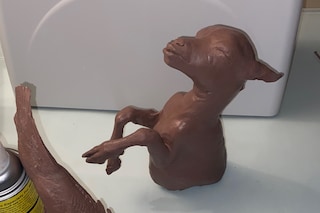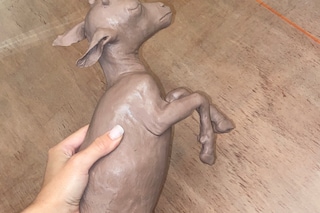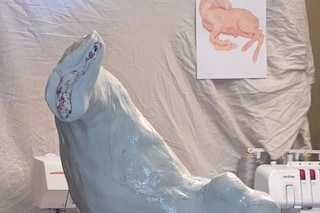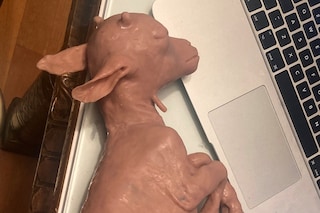CSM student Yasmin Whitlock details the creation of the eerie ‘Capri baby’ – from working with Alexander McQueen collaborator Simon The Stuffa, to raiding fishmongers’ bins for mermaid tails
When FKA twigs dropped her mixtape Caprisongs last month, the album cover saw twigs clad in bedazzled gemstones and pulling her bottom lip down to reveal the acronym GOAT (Greatest Of All Time). The artist is goated, there’s no doubt about it. But she’s also a Capricorn – depicted in astrology as a half-goat, half-fish. So, when the Aidan Zamiri-shot album trailer came out featuring a little baby Capricorn, no one batted an eyelid.
How twigs actually came to procure a tiny goat foetus is a very different story. Sleeping peacefully in a water tank, the baby angel certainly seems like the Real Deal: its wee hairy hooves and fishtail are anatomically on-point, and yet scientifically impossible? It’s the sort of artefact you can imagine seeing in one of those downtown museums of curiosities, buried amid various other taxidermy and occult oddities.
Pulling back the curtain on the making of the goat is its creator, Yasmin Whitlock. The 23-year-old is in her final year studying fashion at Central Saint Martins. “One of my last projects was about human intervention into livestock births, specifically looking at foetal lambs in 2020,” she tells me, “so I couldn’t believe how closely linked this was – it was fate.” When Zamiri began sharing his plans to make a goat baby as part of the Caprisongs visuals, Whitlock jumped at the opportunity: “I actually had a tiny cut out picture of a foetal goat left over from the project stuck on my laptop near my keyboard ever since, so maybe that manifested it.”
In order to create the anatomically accurate Capri baby, Whitlock enlisted the help of Simon The Stuffa, the taxidermist collaborator of Alexander Mcqueen, who opened up his collection of (ethically sourced) taxidermy that included a stillborn baby goat. She later went fishing in the local fishmonger bin to retrieve the tail portion of the foetus. This was made into a clay sculpture, from which a silicone body was created and inserted with 3D printed breathing lungs and a heartbeat, as well as an articulated tail with fibre optic lights.
With her graduate collection on show this spring, Whitlock is honing in themes of prosthetics, deformities and hybridisation. She elaborates, “I’m definitely looking to expand my collection of weird little baby creatures that I have made, so I wouldn’t be too surprised if you see another little silicone hybrid being floating about.”
How did you get involved in the project with twigs and Aidan Zamiri?
Yasmin Whitlock: Last summer twigs and Aidan Zamiri, who directed all the Capri videos, mentioned one day how they were looking to make this goat baby and didn’t realise I had been teaching myself prosthetics and mould-making over lockdown. I jumped at the opportunity and it was so cute of them to trust me to do it without too much previous work to go off, as I was so fresh in the game. I’d made a couple of prosthetics so far and I used to create ceramic hyperrealistic head sculptures before my fashion degree, so assumed I could merge these two crafts together.
So, how did you end up making a baby goat foetus?
Yasmin Whitlock: twigs is a Capricorn which is half goat, half mermaid. So, naturally, they wanted to depict her abstractly as a developing Capricorn foetus in the womb, which is how the Capri baby idea was born. Aidan included goat ultrasounds from a farm vet into the final video, which is so ethereal. I got all choked up when they first showed me, like a mum at her first ultrasound or something.
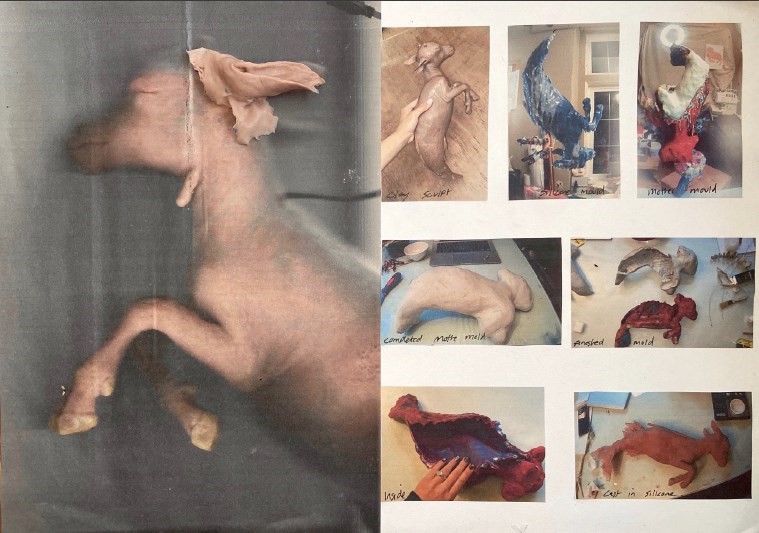
How do you even go about making a goat baby? What was the process like?
Yasmin Whitlock: The process first entailed me visiting Simon The Stuffa who made all the taxidermy pieces for McQueen’s collections whilst he was alive – for example, the ones that incorporated taxidermied birds, horns and a lot of the feathers. twigs actually wore one of the dresses that Simon and McQueen worked on together to the V&A’s opening of their exhibition of his work, which she performed at. I found out when I got to his warehouse, so that was a cute, weird full circle.
Simon has a warehouse full of incredible taxidermy he creates through donated animals that have died of natural causes. Amazingly, he had a stillborn baby goat. I got to take tonnes of pictures of that to reference as I sculpted it, as well as some gorgeous images online of foetal goats. When I first messaged him on Instagram asking if he had one, I knew it was the longest shot ever – when he said he did, I freaked out a bit.
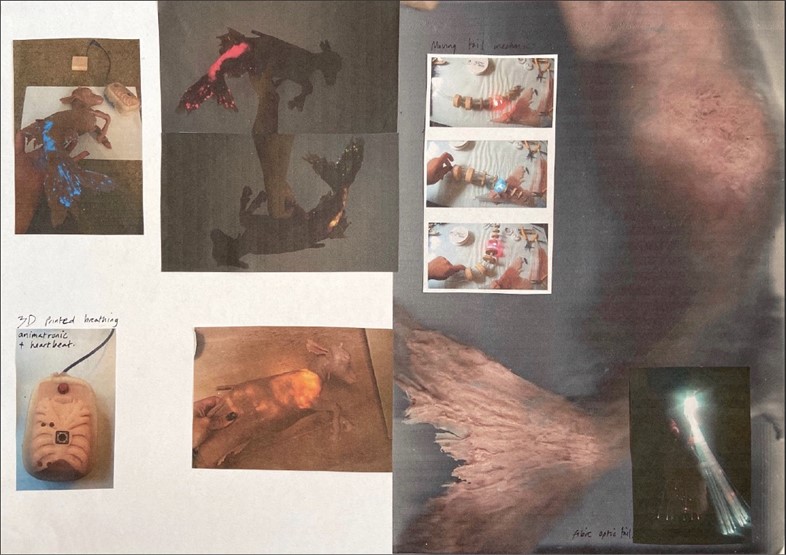
How did you get into fashion? Is it always something you saw yourself working towards?
Yasmin Whitlock: I got into fashion through sculpture – I went from my art foundation looking to enrol on a sculpture degree. But I ended up doing fashion as my tutor convinced me that it is sculpture “just on the body”. I’m really happy I went down that path because it allows me to tailor my concepts into a more specific channel, rather than just any form of sculpture under the sun that can be any scale, material, or context.
Now I need to think technicalities and about armholes, weight distribution, and material toxicity because it’s centres around a human being who has to breathe, talk or walk ideally. It adds another nice challenge to get around, and I enjoy the constraints as I need a bit of a leash to reign in my ideas sometimes.
Your CSM graduate collection is out in May. What are some of the main inspirations behind it?
Yasmin Whitlock: My collection still slightly centres around the idea of reproduction and incorporates levitation, although I won’t say too much. I am casting my own shoes in flexible foam, hopefully using an algae mix and I’m definitely looking to expand my collection of weird little baby creatures that I have made, so I wouldn’t be too surprised if you see another little silicone hybrid being floating about. My garments will maintain my love of sculptural and cast pieces in the form of hardware and soft demi-hardware. I’m also working on a lot kinetic elements and love transformative pieces. My garments usually take up a lot of space, so I like to incorporate a slightly adaptive option into them, to give them as much opportunity to be used and worn in life as possible – things like removable sleeves. or multiway elements. My shoes are adaptive across three sizes so they grow and shrink with you.
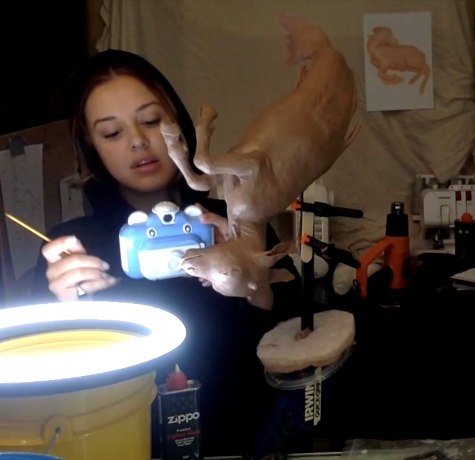
Do you have any formative experiences that shaped the way you see fashion?
Yasmin Whitlock: One of my most formative fashion experiences this year was going to Comic Con. Cosplayers are so skilled and underrated and a lot can be learnt from them; they are my icons. I also made twigs a bag version of the Capri baby in black rubber for her birthday. It was really nice for me to be able to make it into something wearable and useable in real life and translate my Capri baby sculpture onto the body, into its godmother’s arms. Still have to work out twigs’ family lineage to the baby so will call her godmother for now.

